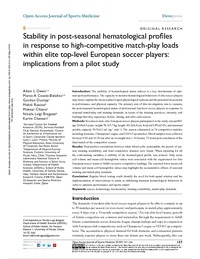Mostrar el registro sencillo de la publicación
Stability in post-seasonal hematological profiles in response to high-competitive match-play loads within elite top-level European soccer players: Implications from a pilot study
| dc.contributor.author | Owen, Adam L. | |
| dc.contributor.author | Cossio-Bolaños, Marco Antonio | |
| dc.contributor.author | Dunlop, Gordon | |
| dc.contributor.author | Rouiss, Medhi | |
| dc.contributor.author | Chtara, Moktar | |
| dc.contributor.author | Bragazz, Nicola Luigi | |
| dc.contributor.author | Chamari, Karim | |
| dc.date.accessioned | 2019-05-28T14:29:53Z | |
| dc.date.available | 2019-05-28T14:29:53Z | |
| dc.date.issued | 2018 | |
| dc.identifier.uri | http://repositorio.ucm.cl/handle/ucm/2185 | |
| dc.description.abstract | Introduction: The stability of hematological status indices is a key determinant of optimal sport performance. The capacity to monitor hematological behaviors of elite soccer players may better explain the stresses placed upon physiological systems and the potential decrements in performance and physical capacity. The primary aim of this investigation was to examine the post-seasonal hematological status of professional top-level soccer players in response to seasonal match-play and training demands, in terms of the training practices, intensity, and loadings that they experience before, during, and after each season. Methods: Seventeen male elite European soccer players participated in the study (mean±SD: age 26.8±4.6 years, weight 78.1±5.7 kg, height 182.4±4.8 cm, body fat 9.8%±2.9%, and maximal aerobic capacity 56.5±4.2 mL kg−1 min−1). The season culminated in 74 competitive matches including domestic, Champions League, and UEFA Cup matches. Blood samples were collected between 9:00 and 10:30 am after an overnight fast (~10 hours), 72 hours post conclusion of the final match of the competitive season. Results: Near-perfect correlations between white blood cells, neutrophils, the period of season, training availability, and total competitive minutes were found. When adjusting for all the confounding variables, a stability of the hematological profile was noticed. Only mean cell volume and mean cell hemoglobin values were associated with the requirement for elite European soccer teams to fulfill excessive competitive loadings. The reported lower mean cell volume and mean cell hemoglobin values may highlight the accumulative effects of seasonal training and match-play demands. Conclusion: Regular blood testing could identify the need for both squad rotation and the implementation of interventions to assist in stabilizing transient hematological behaviors in order to optimize performance and sports output. | es_CL |
| dc.language.iso | en | es_CL |
| dc.rights | Atribución-NoComercial-SinDerivadas 3.0 Chile | * |
| dc.rights.uri | http://creativecommons.org/licenses/by-nc-nd/3.0/cl/ | * |
| dc.source | Open Access Journal of Sports Medicine, 9, 157-166 | es_CL |
| dc.subject | Soccer | es_CL |
| dc.subject | Hematology | es_CL |
| dc.subject | Biochemistry | es_CL |
| dc.subject | Training availability | es_CL |
| dc.title | Stability in post-seasonal hematological profiles in response to high-competitive match-play loads within elite top-level European soccer players: Implications from a pilot study | es_CL |
| dc.type | Article | es_CL |
| dc.ucm.facultad | Facultad de Ciencias de la Educación | es_CL |
| dc.ucm.doi | doi.org/10.2147/OAJSM.S116579 | es_CL |



